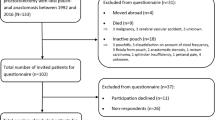PURPOSE
This study was designed to evaluate the impact of childbirth on anal sphincter integrity and function, functional outcome, and quality of life in females with restorative proctocolectomy and ileal pouch-anal anastomosis.
METHODS
The patients who had at least one live birth after ileal pouch-anal anastomosis were asked to return for a comprehensive assessment. They were asked to complete the following questionnaires: the Short Form-36, Cleveland Global Quality of Life scale, American Society of Colorectal Surgeons fecal incontinence severity index, and time trade-off method. Additionally, anal sphincter integrity (endosonography) and manometric pressures were measured by a medical physician blinded to the delivery technique. Anal sphincter physiology also was evaluated with electromyography and pudendal nerve function by nerve terminal motor latency technique.
RESULTS
Of 110 eligible females who had at least one live birth after ileal pouch-anal anastomosis, 57 participated in the study by returning for clinical evaluation to the clinic and 25 others by returning the quality of life and functional outcome questionnaires. Patients were classified into two groups: patients who had only cesarean section delivery after ileal pouch-anal anastomosis (n = 62) and patients who had at least one vaginal delivery after ileal pouch-anal anastomosis (n = 20). The mean follow-up from the date of the most recent delivery was 4.9 years. The vaginal delivery group had significantly higher incidence of an anterior sphincter defect by anal endosonography (50 percent) vs. cesarean section delivery group (13 percent; P = 0.012). The mean squeeze anal pressure was significantly higher in the patients who had only cesarean section delivery (150 mmHg) after restorative proctocolectomy than patients who had at least one vaginal delivery (120 mmHg) after restorative proctocolectomy (P = 0.049). Quality of life evaluated by time trade-off method also was significantly better in the cesarean section delivery group (1) vs. vaginal delivery group (0.9; P < 0.001).
CONCLUSIONS
The risk of the sphincter injury and quality of life measured by time trade-off method are significantly worse after vaginal delivery compared with cesarean section in patients with ileal pouch-anal anastomosis. In the short-term, this does not seem to substantially influence pouch function or quality of life; however, the long-term effects remain unknown, thus obstetric concern may not be the only factor dictating the type of delivery in this group of patients. A planned cesarean section may eliminate these potential and factual concerns in ileal pouch-anal anastomosis patients.
Similar content being viewed by others
REFERENCES
AH Sultan MA Kamm CN Hudson JM Thomas CI Bartram (1993) ArticleTitleAnal-sphincter disruption during vaginal delivery N Engl J Med 329 1905–11 Occurrence Handle8247054
V Donnelly M Fynes D Campbell et al. (1998) ArticleTitleObstetric events leading to anal sphincter damage Obstet Gynecol 92 955–61 Occurrence Handle10.1016/S0029-7844(98)00255-5 Occurrence Handle9840557
RC Bollard A Gardiner GS Duthie SW Lindow (2003) ArticleTitleAnal sphincter injury, fecal and urinary incontinence: a 34-year follow-up after forceps delivery Dis Colon Rectum 46 1083–8 Occurrence Handle10.1007/s10350-004-7284-8 Occurrence Handle12907903
A Ravid CS Richard LM Spencer et al. (2002) ArticleTitlePregnancy, delivery, and pouch function after ileal pouch-anal anastomosis for ulcerative colitis Dis Colon Rectum 45 1283–8 Occurrence Handle10.1007/s10350-004-6411-x Occurrence Handle12394423
D Hahnloser JH Pemberton BG Wolff et al. (2004) ArticleTitlePregnancy and delivery before and after ileal pouch-anal anastomosis for inflammatory bowel disease: immediate and long-term consequences and outcomes Dis Colon Rectum 47 1127–35 Occurrence Handle10.1007/s10350-004-0569-0 Occurrence Handle15164253
JE Ware SuffixJr CD Sherbourne (1992) ArticleTitleThe MOS 36-item Short-Form health survey (SF-36). I. Conceptual framework and item selection Med Care 30 473–83 Occurrence Handle1593914
VW Fazio MG O’Riordain IC Lavery et al. (1999) ArticleTitleLong-term functional outcome and quality of life after stapled restorative proctocolectomy Ann Surg 230 575–86 Occurrence Handle10.1097/00000658-199910000-00013 Occurrence Handle10522727
TH Rockwood JM Church JW Fleshman et al. (1999) ArticleTitlePatient and surgeon ranking of the severity of symptoms associated with fecal incontinence: the fecal incontinence severity index Dis Colon Rectum 42 1525–32 Occurrence Handle10613469
GW Torrance WH Thomas DL Sackett (1972) ArticleTitleA utility maximization model for evaluation of health care programs Health Serv Res 7 118–33 Occurrence Handle5044699
S Gearhart T Hull C Floruta T Schroeder J Hammel (2005) ArticleTitleAnal manometric parameters: predictors of outcome following anal sphincter repair? J Gastrointest Surg 9 115–20 Occurrence Handle10.1016/j.gassur.2004.04.001 Occurrence Handle15623452
A Metcalf RR Dozois RW Beart SuffixJr BG Wolff (1985) ArticleTitlePregnancy following ileal pouch-anal anastomosis Dis Colon Rectum 28 859–61 Occurrence Handle4053900
H Nelson RR Dozois KA Kelly GD Malkasian BG Wolff DM Ilstrup (1989) ArticleTitleThe effect of pregnancy and delivery on the ileal pouch-anal anastomosis functions Dis Colon Rectum 32 384–8 Occurrence Handle2714129
ES Juhasz B Fozard RR Dozois DM Ilstrup H Nelson (1995) ArticleTitleIleal pouch-anal anastomosis function following childbirth. An extended evaluation Dis Colon Rectum 38 159–65 Occurrence Handle10.1007/BF02052444 Occurrence Handle7851170
E Gorgun FH Remzi JM Goldberg et al. (2004) ArticleTitleFertility is reduced after restorative proctocolectomy with ileal pouch-anal anastomosis: a study of 300 patients Surgery 136 795–803 Occurrence Handle10.1016/j.surg.2004.06.018 Occurrence Handle15467664
TC Counihan PL Roberts DJ Schoetz SuffixJr JA Coller JJ Murray MC Veidenheimer (1994) ArticleTitleFertility and sexual and gynecologic function after ileal pouch-anal anastomosis Dis Colon Rectum 37 1126–9 Occurrence Handle10.1007/BF02049815 Occurrence Handle7956581
SJ Snooks M Setchell M Swash MM Henry (1984) ArticleTitleInjury to innervation of pelvic floor sphincter musculature in childbirth Lancet 2 546–50 Occurrence Handle10.1016/S0140-6736(84)90766-9 Occurrence Handle6147604
Author information
Authors and Affiliations
Corresponding author
About this article
Cite this article
Remzi, F., Gorgun, E., Bast, J. et al. Vaginal Delivery After Ileal Pouch-Anal Anastomosis: A Word of Caution. Dis Colon Rectum 48, 1691–1699 (2005). https://doi.org/10.1007/s10350-005-0124-7
Published:
Issue Date:
DOI: https://doi.org/10.1007/s10350-005-0124-7




